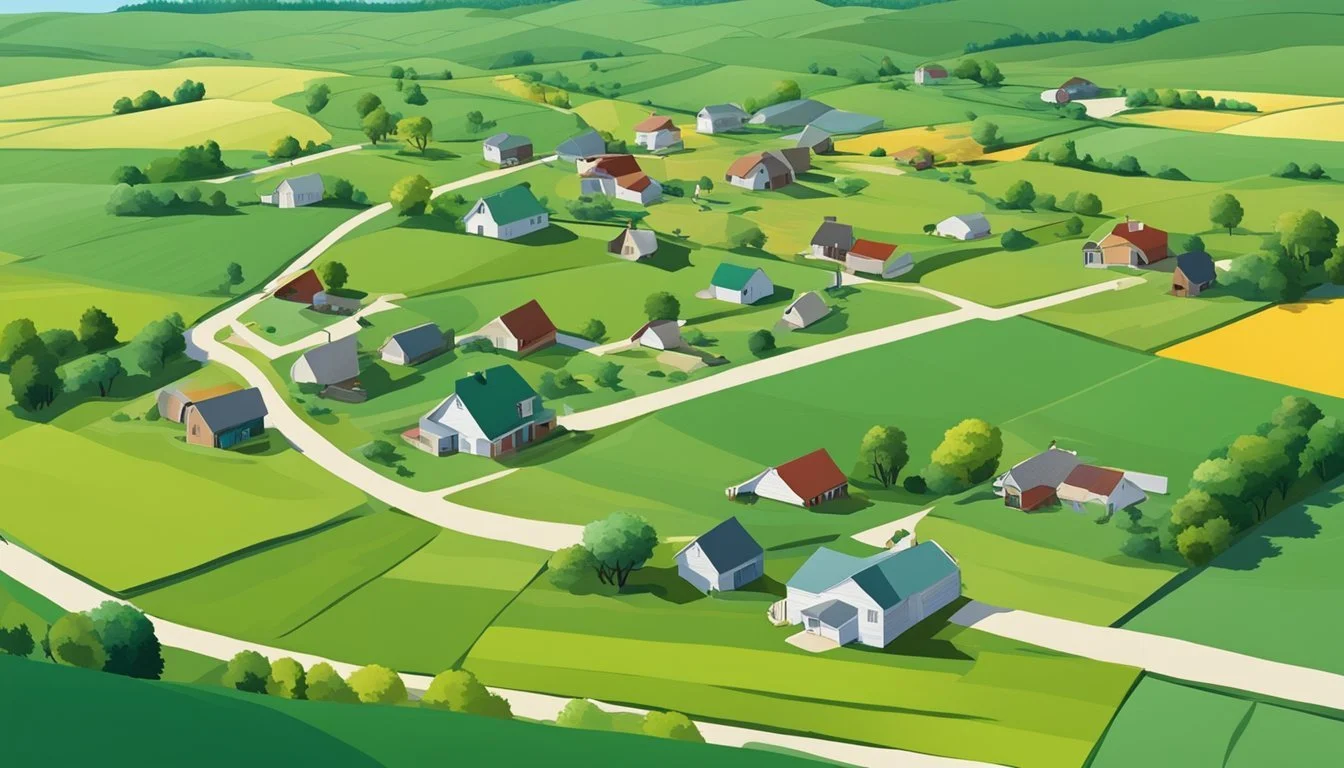Small Farms for Sale in Oklahoma
Your Guide to Buying Local Agricultural Property
This Article is Part of State-by-State Guide to Buying Your First Small Farm
Oklahoma is experiencing a notable interest in the purchase of small farms, a trend driven by the state's diverse agricultural opportunities and its welcoming environment for small-scale operations. The farms for sale span a variety of sizes and configurations, making them appealing to a range of buyers, from those looking to start a hobby farm to others seeking a more sustainable and self-sufficient lifestyle. The state’s inviting rural landscapes offer a backdrop for farming endeavors, with potential for cultivating crops, raising livestock, or even developing a homestead.
With properties available across the state, from the rolling hills of the east to the plains in the west, Oklahoma provides an assortment of small farms tailored to a variety of agricultural pursuits. Listings in Pontotoc County feature sizeable homes on 10-acre plots, while larger spreads in Mayes County present extensive facilities on 20 acres. These farmsteads often come with the necessary infrastructure for immediate operation, attracting farmers ready to engage with the land.
Prospective buyers have a wide price range to consider, starting from under $50,000 to over $250,000, making farm ownership accessible at different investment levels. The market offers options for both established farmers looking to expand and new entrants eager to plant their roots in Oklahoma’s fertile soil. As a result, the state’s agricultural landscape is a mosaic of small farms, each contributing to the local economy and the fabric of rural life.
Understanding Small Farms
Small farms contribute significantly to the agricultural landscape in Oklahoma through their diverse operations and manageable sizes. They play a vital role in local economies and food systems.
Definition and Size
A small farm in Oklahoma is typically defined by the number of acres it covers. Generally, a small farm can range from under 10 acres to about 50 acres. These sizes allow for a range of agricultural activities and are often considered more personal and family-oriented than larger industrial farms.
Types of Small Farms
There are various types of small farms, each specializing in different products or services:
Hobby Farms: Often fewer than 10 acres and used for personal enjoyment or supplementary income.
Micro Farms: Generally under 5 acres and intensely cultivated for high-value crops.
Subsistence Farms: Aiming to be self-sufficient, these farms grow a variety of crops and may include livestock to feed the family owning the land.
Commercial Farms: Though small, these farms produce enough to generate a primary income for the farmer.
Role in Oklahoma's Agriculture
Small farms hold an essential place in Oklahoma's agriculture. They provide a range of agricultural products that might not be viable on a larger scale. Many of these farms focus on local, sustainable, and organic farming practices. Regardless of type, the number of acres a small farm encompasses does not diminish its value in supporting local communities and contributing to the state's agricultural diversity.
Benefits of Small Farm Ownership
Owning a small farm in Oklahoma presents tangible benefits, from economic gains to enhancing local ecosystems and communities.
Economic Advantages
Small farms in Oklahoma can offer significant economic benefits due to the state's low land costs. Prospective owners often find an attractive entry point into agriculture, with opportunities to cultivate diverse crops and livestock.
Lower Initial Investment: Compared to other states, Oklahoma's cheaper land rates allow for a more affordable initial investment.
Potential for Diversification: Owners have the flexibility to diversify agricultural endeavors, increasing potential revenue streams.
Sustainability and Biodiversity
Owners of small farms can directly contribute to sustainability efforts, enhancing biodiversity through various agricultural practices.
Soil Conservation: Small-scale farming allows for more attentive soil management, promoting healthier ecosystems.
Support for Local Species: With controlled farming practices, small farms help in preserving local flora and fauna.
Community Impact
Oklahoma's small farms are at the heart of their local communities, providing fresh, locally-grown produce, and fostering a culture of self-reliance.
Fresh Local Produce: They offer community access to fresh foods and often participate in farmers' markets.
Social Engagement: These farms create opportunities for community involvement and education about sustainable agriculture.
Finding Small Farms for Sale
When seeking out small farms for sale in Oklahoma, potential buyers can utilize various resources to find properties that meet their specific needs and preferences.
Real Estate Listings
Real estate listings are a primary resource for finding small farms on the market. Detailed listings can provide information such as acreage, location, property size, and price. For instance, in Pontotoc County, a 10-acre farm with a 3,000 square foot home is listed at $675,000, and in Tulsa County, a 13-acre property has recently been made available.
Working with Realtors
Working with realtors who specialize in farm properties can offer personalized assistance in the search. Realtors may have access to listings before they are broadly advertised and can help buyers navigate through the complexities of purchasing rural properties, ensuring they find the ideal small farm in Oklahoma.
Online Marketplaces
Online marketplaces and specialized platforms for farm sales are increasingly popular. These platforms aggregate listings from various sources, providing a broad view of available properties. Prices may range from under $50,000 to over $2,000,000, with properties varying considerably in size and features—demonstrating the diverse options within Oklahoma's market for small farms.
Assessing Farm Potential
Before investing in a small farm in Oklahoma, potential buyers must consider the quality of the land, available water resources, and the applicable zoning laws and regulations. These factors are critical in determining the farm's potential for productivity and sustainability.
Evaluating Land Quality
The quality of the agricultural land is crucial for farming success. Buyers should assess the soil type, fertility levels, and topography. For instance, a property in Pontotoc County might feature 10 acres of land with a history of productive yields. Conversely, other properties might require soil amendments to reach optimal fertility. It's advisable to conduct soil tests and consider the acreage in relation to the type of farming intended.
Water Resources and Irrigation
Water access is another vital aspect of farm potential. Buyers should investigate existing irrigation systems, the reliability of water sources, and the potential for future water development. Farms with established water resources, like a property with 20 acres in Mayes County featuring a large-scale irrigation system, will provide a more secure investment compared to a farm where water access is uncertain or requires substantial investment.
Zoning and Regulations
Buyers must be aware of zoning laws and regulations that can affect farming operations. The acreage of a property can influence local zoning restrictions, which may impact the type of agricultural activities allowed. For example, a 40-acre farm in a rural Oklahoma county might fall under different regulations than a smaller, 4.2-acre hobby farm near a densely populated community. It is essential to ensure compliance with these regulations before making a purchase.
Purchase Process
The purchase process for small farms in Oklahoma is a multifaceted endeavor that requires attention to detail at each step. Potential buyers must be prepared to engage in several key phases, from the initial offer to the final closing of the deal.
Making an Offer
When a buyer finds an Oklahoma farm that meets their criteria, the first step is to make an offer. This usually involves:
Drafting a written proposal: The buyer indicates the price they are willing to pay and may include contingencies such as financing or selling a current property.
Earnest money: A deposit made by the buyer to show they are serious about the purchase.
Inspections and Appraisals
Prior to finalizing the sale, the buyer should ensure that inspections and appraisals are conducted:
Property inspection: Conducted by a licensed inspector to uncover any potential issues with the land or structures.
Appraisal: A professional appraisal to determine the property's market value, often required by lenders.
Closing the Deal
Closing is the final step in the purchase process, where ownership is officially transferred to the buyer:
Closing documents: These documents must be reviewed and signed by both parties. They often include the deed, bill of sale, and loan documents.
Final payments: The buyer settles any remaining balances with the seller, and both parties pay any necessary fees.
Financing Options
Prospective buyers interested in small farms for sale in Oklahoma have diverse financing options that cater to a variety of needs and situations.
Loans and Grants
Financial institutions offer agricultural loans specifically tailored for farm purchases, with competitive interest rates and repayment terms. These loans are typically secured by the property itself. Grants may be available for farms engaged in certain types of production or conservation practices, though these usually do not require repayment.
Investor Financing
Individuals may seek partner investors or owner financing to purchase farmland. Owner financing is a significant option in Oklahoma, where sellers offer direct financing, sometimes with more flexible terms than traditional lenders. It's important for buyers to ensure clear terms and legal protection with this arrangement.
Government Programs
The United States Department of Agriculture (USDA) operates several programs to assist farmers, including the Farm Service Agency (FSA) loans which support family-sized farms. Additionally, Oklahoma's state agriculture programs may offer localized financial assistance or incentives for farming operations.
Starting a Small Farm in Oklahoma
When starting a small farm in Oklahoma, it is essential for prospective owners to carefully plan their business, understand land management, and make informed decisions about crop and livestock selection.
Business Planning
Farm owners must develop a detailed business plan that outlines their farming goals, market analysis, and financial projections. This plan should include a budget that accounts for the costs of land, equipment, seeds, livestock, and any additional labor. A well-constructed business plan can assist in securing loans or grants that may be available for agricultural enterprises.
Land Management
Effective land management is critical for the sustainability of a farm. Soil testing can determine the nutrient profile and help decide which crops will thrive. Proper irrigation, crop rotation, and pest control strategies are also integral to maintaining a healthy farm ecosystem. Prospective farmers should consider the average land price in Oklahoma, which stands at $11,797 per acre, as a factor in their land management budgeting.
Crop and Livestock Selection
Choosing the right crops and livestock depends on the farm's specific objectives, as well as Oklahoma's climate and soil conditions. Common crops include wheat, soybeans, cotton, and hay, while popular livestock options range from cattle and horses to goats and sheep. The selection should align with market demand and resource availability, ensuring that farm operations are both productive and profitable.
Challenges and Considerations
When considering purchasing small farms in Oklahoma, potential buyers should assess specific challenges related to weather patterns, economic conditions, and the farm's long-term viability.
Weather-Related Risks
Oklahoma's climate presents a range of weather-related risks that can impact farming operations. Buyers should be aware that:
Tornadoes: The state sits within Tornado Alley, leading to a higher frequency of these destructive storms.
Drought: Periods of drought can be severe, potentially leading to restrictions on water use and diminished crop yields.
Market Fluctuations
The agricultural market is subject to:
Commodity Prices: Changes in commodity prices can significantly affect farm profitability.
Input Costs: Variations in the costs of seeds, fertilizers, and fuels can alter operating budgets.
Long-Term Sustainability
Buyers must consider:
Soil Health: Maintaining soil fertility through sustainable practices is crucial to long-term productivity.
Water Resources: Given the risk of drought, water rights and access to reliable water sources are significant concerns.





